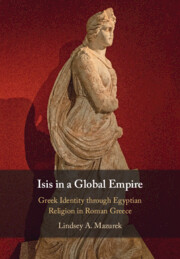Refine search
Actions for selected content:
5894 results in Classical art and architecture
Appendix - Appendices
-
- Book:
- Isis in a Global Empire
- Published online:
- 06 February 2022
- Print publication:
- 24 February 2022, pp 195-200
-
- Chapter
- Export citation
Chapter Six - Self-location
-
- Book:
- Isis in a Global Empire
- Published online:
- 06 February 2022
- Print publication:
- 24 February 2022, pp 145-185
-
- Chapter
- Export citation
Chapter Three - Deterritorializing Theology?
-
- Book:
- Isis in a Global Empire
- Published online:
- 06 February 2022
- Print publication:
- 24 February 2022, pp 59-87
-
- Chapter
- Export citation
Chapter Four - Self-understanding
-
- Book:
- Isis in a Global Empire
- Published online:
- 06 February 2022
- Print publication:
- 24 February 2022, pp 88-119
-
- Chapter
- Export citation
Index
-
- Book:
- Isis in a Global Empire
- Published online:
- 06 February 2022
- Print publication:
- 24 February 2022, pp 275-278
-
- Chapter
- Export citation
Bibliography
-
- Book:
- Isis in a Global Empire
- Published online:
- 06 February 2022
- Print publication:
- 24 February 2022, pp 245-274
-
- Chapter
- Export citation
Illustrations
-
- Book:
- Isis in a Global Empire
- Published online:
- 06 February 2022
- Print publication:
- 24 February 2022, pp vii-x
-
- Chapter
- Export citation
Chapter Five - Self-fashioning
-
- Book:
- Isis in a Global Empire
- Published online:
- 06 February 2022
- Print publication:
- 24 February 2022, pp 120-144
-
- Chapter
- Export citation

Isis in a Global Empire
- Greek Identity through Egyptian Religion in Roman Greece
-
- Published online:
- 06 February 2022
- Print publication:
- 24 February 2022
Works Cited
-
- Book:
- Gothic Kernow
- Published by:
- Anthem Press
- Published online:
- 02 March 2022
- Print publication:
- 11 January 2022, pp 75-80
-
- Chapter
- Export citation
Frontmatter
-
- Book:
- Gothic Kernow
- Published by:
- Anthem Press
- Published online:
- 02 March 2022
- Print publication:
- 11 January 2022, pp i-iv
-
- Chapter
- Export citation
Index
-
- Book:
- Gothic Kernow
- Published by:
- Anthem Press
- Published online:
- 02 March 2022
- Print publication:
- 11 January 2022, pp 81-82
-
- Chapter
- Export citation
2 - Supersensory Gothic Kernow: Magic, Mysticism, and The Esoteric Aesthetics of Emergence
-
- Book:
- Gothic Kernow
- Published by:
- Anthem Press
- Published online:
- 02 March 2022
- Print publication:
- 11 January 2022, pp 31-48
-
- Chapter
- Export citation
Introduction
-
- Book:
- Gothic Kernow
- Published by:
- Anthem Press
- Published online:
- 02 March 2022
- Print publication:
- 11 January 2022, pp 1-10
-
- Chapter
- Export citation
1 - Dark Romance and Du Maurier’s Gothic Kernow
-
- Book:
- Gothic Kernow
- Published by:
- Anthem Press
- Published online:
- 02 March 2022
- Print publication:
- 11 January 2022, pp 11-30
-
- Chapter
- Export citation
3 - Strange Folk: Folk Horror Cultures, Ritual, and Witching Women
-
- Book:
- Gothic Kernow
- Published by:
- Anthem Press
- Published online:
- 02 March 2022
- Print publication:
- 11 January 2022, pp 49-74
-
- Chapter
- Export citation
Contents
-
- Book:
- Gothic Kernow
- Published by:
- Anthem Press
- Published online:
- 02 March 2022
- Print publication:
- 11 January 2022, pp v-vi
-
- Chapter
- Export citation
Glossary
-
- Book:
- The Origins of Concrete Construction in Roman Architecture
- Published online:
- 15 June 2021
- Print publication:
- 24 June 2021, pp 252-259
-
- Chapter
- Export citation
Appendix - Catalog of Sites
-
- Book:
- The Origins of Concrete Construction in Roman Architecture
- Published online:
- 15 June 2021
- Print publication:
- 24 June 2021, pp 244-251
-
- Chapter
- Export citation
One - Introduction
-
- Book:
- The Origins of Concrete Construction in Roman Architecture
- Published online:
- 15 June 2021
- Print publication:
- 24 June 2021, pp 1-24
-
- Chapter
- Export citation
